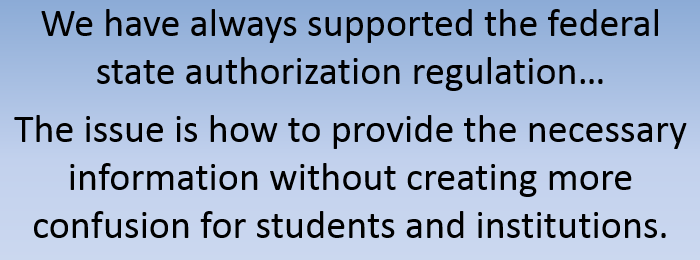As one of my favorite columnists, Dave Barry, used to say, “I am not making this up!” Maybe what I am about to share isn’t as exciting to you as last week’s release of “Avengers: Endgame” or Sunday’s “Game of Thrones” episode, but I kid you not, we are living in real life plot twisting times with the Federal Regulations for State Authorization.
 Just two weeks ago, we reported that we thought that maybe we were seeing the end to the Federal Regulations Groundhog’s Day loop. We shared that after roughly 10 years the negotiated rulemaking consensus brought the potential for some actual logical and enforceable state authorization Federal regulations that showed protection for students and a reasonable process for institutions.
Just two weeks ago, we reported that we thought that maybe we were seeing the end to the Federal Regulations Groundhog’s Day loop. We shared that after roughly 10 years the negotiated rulemaking consensus brought the potential for some actual logical and enforceable state authorization Federal regulations that showed protection for students and a reasonable process for institutions.
…..but then the next plot twist came! What will be the ending now? Can we predict the next plot point? Are there clues from previous federal regulation episodes that we can re-watch to help us reach the final episode of this state authorization drama?
Most importantly…what real life consequences does this unfolding drama have on institutions and students?
The Facts
On Friday, April 26, 2019, two online news sources, Courthouse News Service and in PoliticoPro (a subscriber edition) reported that a California judge planned to side with the plaintiff in the case brought by the NEA & the California Teachers Association challenging the delay of the State Authorization Federal Regulations that were to be effective July 1, 2018. In plain English, it means that U.S. Magistrate Judge Laurel Beeler intends to find that the delay of the regulations was illegal. Important plot point: there is no written ruling as of this date.
Judge Beeler is reported to have shared that her decision is due to the Department of Education’s failure to offer negotiated rulemaking in regard to the delay and that the 15 day public comment period was not sufficient to create the delay of the effective date. The Judge is also reported to have said that she is considering putting the ruling on hold for 30 days to give the Department time to prepare for implementation of the regulations. In reading the two articles mentioned, it is not clear if that is 30 days to prepare guidance or 30 days for implementation to occur.
The Department has not commented directly on this decision. Our reporting of the events and statements of the April 25, 2019 hearing are from the previously mentioned articles.
Professional Licensure Disclosure Issue
The main crux of this lawsuit was about the delay of required disclosures for programs leading to professional licensure. A lawyer with the California Teachers Association is quoted as saying, “Students were left in the dark when the department delayed this rule.” What the lawyer and the article did not share is that there are several other legal sources requiring institutions to provide disclosures:
- Misrepresentation Federal Regulation 34 CFR 668.72(c)(2) specifically requiring institutions to not mislead students about the ability to meet licensure requirements;
- State approvals and professional board requirements in many states; and
- SARA required disclosures for all SARA participating institutions.
We have addressed these other requirements in a February 2018 Frontiers Post.
The lawyer representing the Department asked Judge Beeler for time for the Department to issue guidance if the rules are to take effect. The plaintiffs are reported to have responded with the notion that 30 days should be the maximum time offered for implementation. The Judge is reported to have a sense of agreement and is also reported to have stated, “The educational institutions had 17 months from December 2016 to May 2018” to prepare. Of course, that expectation is problematic since the official word from the Department was that the regulation was delayed and institutions remained unclear as to what path to take to compliance.
 What appears to have been missed here is that the essence of the delay was the confusion about proper institutional implementation. The Department’s May 25, 2018 announcement was very clear about their unexpected realization of the confusing regulatory language. They cited two letters that opened their eyes to the concern that would cause confusion for students and institutions if the regulations were to become effective July 1, 2018. One of these letters was a joint letter from WCET, DEAC and NC-SARA. The institutions were basically begging for guidance and understanding about how to undergo putting in place institutional processes to manage the research required as well as knowing what state they were researching – was it residence or location of the activity? Our letter was only one of several communications with the Department in which we asked for more guidance on exactly how institutions were to comply.
What appears to have been missed here is that the essence of the delay was the confusion about proper institutional implementation. The Department’s May 25, 2018 announcement was very clear about their unexpected realization of the confusing regulatory language. They cited two letters that opened their eyes to the concern that would cause confusion for students and institutions if the regulations were to become effective July 1, 2018. One of these letters was a joint letter from WCET, DEAC and NC-SARA. The institutions were basically begging for guidance and understanding about how to undergo putting in place institutional processes to manage the research required as well as knowing what state they were researching – was it residence or location of the activity? Our letter was only one of several communications with the Department in which we asked for more guidance on exactly how institutions were to comply.
You may recall that, last April as the effective date was drawing closer and with no Department guidance, we provided the best implementation direction we could, given the circumstances.
Impact of Negotiated Rulemaking Consensus
Fade to another location as we see the movement and impact of Federal Rulemaking…… The 2019 Negotiated Rulemaking came to consensus on all issues presented to the main committee including regulations for State Authorization. We anticipate the proposed rules to be released after review by the Department for any legal, technical, or grammatical errors. With these proposed rules will come a public comment period. The Department will then review comments in preparation of the final regulations. It is anticipated that the final regulations will be released by November 1, 2019. If that occurs, the new regulations will be effective July 1, 2020. These regulations will replace any existing regulations. This includes new state authorization regulations in place of any then effective state authorization regulations. This plot point is moving forward until we hear otherwise.
So, if the 2016 delayed Federal regulations for state authorization must become effective, they would be effective for possibly one year. Really one year? Yes, if the court requires that the regulations become effective sometime soon, say mid 2019, then those regulations would potentially be replaced with a new set of regulations on July 1, 2020. How easy do you think this will be for institutions and students to understand?
Specifically, we are concerned about confusion and harm to students that could occur if these 2016 delayed rules as written become effective and enforceable for the next year while waiting for the new regulations. Due to the implementation problem around the confusion of residence vs. location of activity that we addressed immediately when the 2016 Federal regulations were first released, we are concerned that students may get incorrect information regarding an institution’s status in their state and/or complaint processes to follow. Rather than helping, the required information would be to the student’s detriment.
Considerable time was spent in the negotiated rulemaking subcommittee about understanding the difference between residence and location. The main committee revised the proposed subcommittee language based upon the ground work laid by the subcommittee. The new regulations that reached consensus focused on the location of the activity.
A Parallel Story
Here are highlights of the timeline for State Authorization’s fraternal twin brother, Borrowers Defense Federal Regulation. Why do we mention this regulation? You want to see what we can learn from a regulation that appears to be walking a familiar (but certainly not identical) legal path. See any similarities?
- New Borrowers Defense to Repayment regulations were released November 1, 2016 during the Obama administration.
- The final rule was set to take effect July 1, 2017.
- A lawsuit was filed May 2017 alleging four aspects of the regulations were unlawful.
- June 16, 2017 the Department announced delay of the effective date until the judicial challenges were resolved.
- June 16, 2017 (same day) the Department published notice for Negotiated Rulemaking to revise the regulations.
- Continued delay until July 1, 2018 announced by the Department for good cause.
- October 24, 2017 Department issued a notice or proposed rulemaking delaying an effective date to July 1, 2019.
- The Department released new proposed regulation in the July of 2018.
- 38,000 plus public comments were received regarding the proposed regulations.
- September 2018 U.S. District Court ruled that the Borrower Defense rule delay was unlawful and gave the Department until October 12 to offer the court a more detailed rationale or the November 2016 rule would be reinstated.
- October 12, 2018 – no rationale by the Department was submitted.
- November 1, 2018 – Deadline for final regulations not met for purpose of July 1, 2019 effective date.
- NOW – Regulations that were released November 1, 2016 are effective. The Department recently stated that they are still reviewing public comments and intend to release a final regulation.
A plot difference to share here is that the U.S. District Court’s initial ruling on the delay offered the Department a deadline to share something to potentially change the court’s mind. Based on the reporting of the State Authorization lawsuit, the Court will set a deadline with a court order to set the effective date. The language of Judge Beeler’s ruling is something we look forward to reviewing.
“Effective” vs. “Enforcement”
We have often shared the timeline for the history of the Federal Regulation for State Authorization. The 2010 regulation was vacated by the courts, but prior to the U.S. Circuit Court of Appeals upholding the decision of the U.S. District court’s decision to vacate the regulation on procedural grounds, the Department, in a Dear Colleague Letter on April 11, 2011, indicated that it would postpone “enforcement” of the regulation until July 1, 2014. The regulations, as released in 2010, became effective on July 1, 2011. The “effective” date of the regulation for State Authorization for Distance Education was not delayed. However, the enforcement date was shared as three years after the effective date. Please note the difference in the words effective vs. enforcement.
One wonders, despite a ruling from Judge Beeler directing that the regulation is to become effective, if the Department will choose to delay the enforcement of the regulation to wait for the new regulation that was created during 2019 Negotiated Rulemaking? The question in 2011 was related to the challenge of the acquisition of information from the state higher education agencies in each state. Today, the 2016 language requires institutions to supply the educational prerequisites for professional licensure or certification programs offered at distance and a determination whether the institution meets those prerequisites. That would mean 50 states for potentially more than 50 different professions.
Additionally, this is an unclear mandate given that the federal regulations indicate providing information based on the student’s residence, but the state would require location. Some legal minds have indicated that the institution should provide information under both residence and location in order to ensure compliance. Since the original intent of state authorization is to rely on state requirements, it is odd and confusing that the 2016 language used a different criterion – the student’s residence.
The 2019 consensus language — that will likely move forward — requires that, based solely on the student location, the institution will indicate whether the institution does meet prerequisites, does not, or has not made the determination. If the institution does not meet prerequisites or if the institution has not made the determination, the student will receive direct notification to that effect.
 Given the difference in the requirements, does it make sense to enforce unclear rules with one set of requirements when a new set of rules will likely be in place a year later? The likelihood is chaos for the institutions to implement processes to both comply with the 2016 regulations and put in place processes to be in compliance for July 1, 2020.
Given the difference in the requirements, does it make sense to enforce unclear rules with one set of requirements when a new set of rules will likely be in place a year later? The likelihood is chaos for the institutions to implement processes to both comply with the 2016 regulations and put in place processes to be in compliance for July 1, 2020.
Practical Steps
Institutional personnel should not just step out for more popcorn to see where this story goes. The foundation for compliance remains focused on helping our students. We know from negotiated rulemaking that protecting students with reasonable and responsible processes by the institutions is the goal.
As we shared two weeks ago, most of the notification requirements of the 2016 delayed regulations were already required elsewhere in the Federal Code. One exception was the professional licensure notifications, which had no specific requirement. However, the failure to notify students about licensure statues is listed as a specific example of the misrepresentation rules. Therefore, there already is an effective and enforceable prohibition for misrepresentation for misleading the student intentionally or unintentionally about meeting professional licensure requirements.
A distinction between the 2016 regulations and possible 2019 regulations is the format of compliance. The format for communicating the information to the student differs in these two sets of regulations as does direction about which state is appropriate to meet the student’s needs.
Without a written court ruling and guidance from the Department, it is difficult to offer direction. However, subject to approval of an institution’s legal counsel, we believe the spirit of the rules is to supply the information that best serves the student. Therefore, we believe sharing information based on the location of the student while participating in the program leading to professional licensure will best serve the student. We suggest you review our implementation thoughts from April 2018.

We Have Always Preached Compliance and Championed Notifications for Students
Additionally, if your institution is considering waiting out this drama until the final scene. Don’t!
You may wish to share that SAN has always advocated that institutions should keep students sufficiently informed about programs leading to professional licensure and certification for the following reasons:
- Federal Regulations for Misrepresentation: 34 CFR 668.71 and 34 CR 668.72.
- SARA notification requirements: SARA Manual Section 5.2.
- Liability mitigation/avoidance to the institution.
- Moral obligation to the student by the institution.
I am amused to think for a second that the purpose of this Federal court yet to be released ruling was like Thanos’ snap to cause half of the institutions in the country to be out of compliance. But no, I do believe that the ultimate purpose of the lawsuit and the upcoming ruling is to protect and serve students with the information they need. WCET and SAN have always been in support of the philosophy of these Federal regulations that support institution compliance in the states and provide students with clear understanding of licensure and certification possibilities as they pursue professional occupations.
The issue is how to provide the necessary information without creating more confusion for students and institutions.
We do not want a legal case that was fought on the basis of protecting students to actually cause them more harm.
Very simply. If you follow the state laws, you should be well on your way to compliance with federal regulations. If you have not done so yet, then start yesterday.
WCET and SAN will continue to follow the progress of this lawsuit and its implications. Additionally, we will continue with our fourth and final installment of our series about the outcomes of the 2019 Negotiated Rulemaking.

Cheryl Dowd
Director, State Authorization Network
WCET – the WICHE Cooperative for Educational Technologies
cdowd@wiche.edu

Dan Silverman
Assistant Director, State Authorization Network
WCET – the WICHE Cooperative for Educational Technologies
dsilverman@wiche.edu

 Just two weeks ago, we reported that we thought that maybe we were seeing the
Just two weeks ago, we reported that we thought that maybe we were seeing the  What appears to have been missed here is that the essence of the delay was the confusion about proper institutional implementation.
What appears to have been missed here is that the essence of the delay was the confusion about proper institutional implementation.  Given the difference in the requirements, does it make sense to enforce unclear rules with one set of requirements when a new set of rules will likely be in place a year later? The likelihood is chaos for the institutions to implement processes to both comply with the 2016 regulations and put in place processes to be in compliance for July 1, 2020.
Given the difference in the requirements, does it make sense to enforce unclear rules with one set of requirements when a new set of rules will likely be in place a year later? The likelihood is chaos for the institutions to implement processes to both comply with the 2016 regulations and put in place processes to be in compliance for July 1, 2020.



5 replies on “State Authorization Lawsuit: Court and Ed Department Need to Work Together to Avoid Causing More Confusion for Students and Institutions”
[…] ineligible for Federal Financial Aid, and without recourse. In the letter about the court ruling, WCET and SAN shared that we knew these regulations would become effective, but that we hoped the Department would […]
[…] Trump administration had sought to delay those regulations, set to go into effect a year ago, but a judge ruled recently that they be […]
[…] Federal Regulations that had been delayed in July 2018. That delay of the regulations was then vacated by the U.S. District Court ruling causing the 2016 Federal Regulations to become effective on May 26, 2019. Those 2016 State […]
[…] to become effective in 2018 get delayed at the last second. Then the delayed regulations became effective due to a court ruling. Meanwhile, consensus language that included professional licensure disclosures for all modalities […]
[…] for state authorization of distance education has had a sorted history and has been subject to political and court battles over the past ten years. The original Federal regulation for state authorization of distance […]